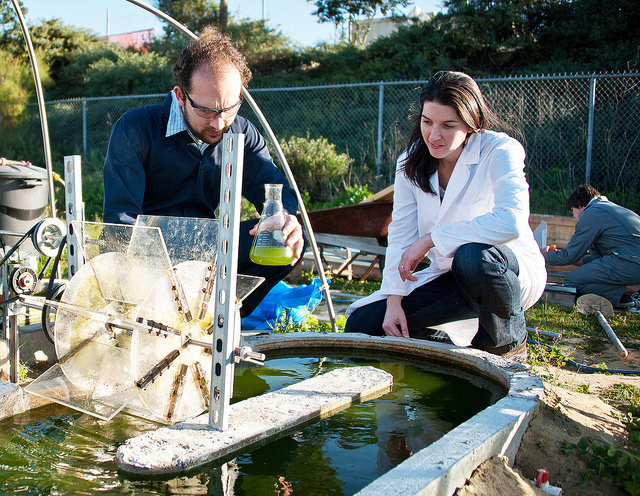
Photo: Flickr/Gates Foundation https://creativecommons.org/licenses/by-nc-nd/2.0/legalcode
What are Emerging Fuels?
Emerging fuels are alternative fuels that are under development or already in use. Like other alternatives, these fuels can increase energy security, reduce emissions, improve vehicle performance, and stimulate the economy. Some may also qualify for federal and state incentives and are considered alternative fuels under the Energy Policy Act of 1992.
Below are brief overviews of the emerging alternative fuels in the market provided by the Alternative Fuels Data Center’s Emerging Alternative Fuels page.
Biobutanol (Butyl Alcohol):
Composition and Production: Biobutanol is a 4-carbon alcohol that can be produced from the same feedstocks as ethanol, including corn, sugar beets, and other biomass wastes.
Use as a Transportation Fuel: Biobutanol can be blended with other fuels for use in conventional gasoline vehicles. Similar to methanol and ethanol, biobutanol blends of 85% or more with gasoline are alternative fuels under the Energy Policy Act of 1992.
Benefits: Benefits include higher energy content, increased energy security, and fewer emissions. Biobutanol has higher energy content because its energy density is 10% to 20% lower than gasoline’s, which makes its energy content relatively high among gasoline alternatives. Biobutanol can be produced domestically from a variety of feedstocks which increases energy security, while creating U.S. jobs. Finally, biobutanol produces fewer emissions because the carbon dioxide captured by growing feedstocks reduces overall greenhouse gas emissions by balancing carbon dioxide released from burning biobutanol.
For more information please see the Alternative Fuels Data Center (AFDC) Biobutanol page.
Drop-In Biofuels:
Composition and Production: Drop-in biofuels are hydrocarbon fuels that are substantially similar to petroleum-based gasoline, diesel, or jet fuels. They can be produced from various biomass feedstocks, such as crop residues, woody biomass, dedicated energy crops, vegetable oils, fats, greases or algae.
Use as a Transportation Fuel: Drop-in biofuels are in an early stage of development, with several commercial plants in the United States and abroad. The goal for drop-in fuels is to meet existing diesel, gasoline, and jet fuel quality specifications and be ready to “drop-in” to existing infrastructure by being chemically indistinguishable from petroleum derived fuels.
Benefits: Benefits include engine and infrastructure compatibility, increased energy security, fewer emissions, and more flexibility. Drop-in fuels are expected to be substantially similar to their petroleum counterparts and therefore minimize compatibility issues with existing infrastructure and engines. Drop-in fuels increase energy security because they can be produced domestically from a variety of feedstocks. Carbon dioxide captured by growing feedstocks reduces overall greenhouse gas emissions by balancing carbon dioxide released from burning drop-in fuels so there are also fewer emissions released. Drop-in fuels are replacements for diesel, jet fuel, and gasoline so there is more flexibility with this fuel, allowing for multiple products from various feedstocks and production technologies.
For more information please see the Alternative Fuels Data Center (AFDC) Drop-In Biofuels page.
Methanol:
Composition and Production: Methanol, or wood alcohol, has similar chemical and physical fuel properties to ethanol. Methanol can be produced using various feedstocks, including carbon-based feedstocks, such as coal. However, natural gas is currently the most economical feedstock.
Use as a Transportation Fuel: In the 1990s, 100% methanol and 85% methanol/15% gasoline blends (M85) were used in compatible vehicles, similar to ethanol flexible fuel vehicles (FFVs) on the market today. The National Renewable Energy Laboratory is currently researching ways to use methanol for fuel cell vehicles.
Benefits: Benefits include lower production costs, improved safety, and increased energy security. Methanol is cheap to produce relative to other alternative fuels and therefore has lower production costs. There is improved safety when dealing with methanol because it has a lower risk of flammability than gasoline. Methanol can be manufactured from a variety of carbon-based feedstocks, such as coal so its use can also help reduce U.S. dependence on imported petroleum and increase energy security.
For more information please see the Alternative Fuels Data Center (AFDC) Methanol page.
Renewable Natural Gas (Biomethane):
Composition and Production:Renewable natural gas (RNG), also known as biomethane, is pipeline-quality gas that is fully interchangeable with fossil natural gas. RNG is essentially biogas (also known as swamp gas, landfill gas, or digester gas) that has been processed to purity standards. Biogas is typically composed of 50-80% methane, 20-50% carbon dioxide, and trace gases such as hydrogen, carbon monoxide, and nitrogen. It is produced by decomposing organic matter, such as sewage, animal byproducts, and agricultural, industrial, and municipal solid wastes and therefore can be produced from landfills, which are the 3rd largest source of human-related methane emissions in the U.S. Biogas can also be recovered in livestock operations by collecting animal manure and delivering it to an anaerobic digester, which stabilizes and optimizes methane production.
Use as a Transportation Fuel: Renewable natural gas can be used in existing natural gas vehicles without modification but must be refined to meet pipeline specifications.
Benefits: Benefits include increased energy security, fewer emissions, better economics, and a cleaner environment. Biogas offsets non-renewable resources, such as coal, oil, and fossil fuel-derived natural gas therefore increasing energy security. It reduces emissions by preventing methane release in the atmosphere which is 21 times stronger than carbon dioxide as a greenhouse gas. Biogas also reduces the cost of complying with EPA combustion requirements for landfill gas and therefore makes better economic sense. Finally, producing biogas through anaerobic digestion reduces landfill waste and odors, produces nutrient-rich liquid fertilizer, and requires less land than aerobic composting.
For more information please see the Alternative Fuels Data Center (AFDC) Renewable Natural Gas page.
xTL Fuels (Fischer-Tropsch):
Composition and Production: Synthetic liquid transportation fuels, otherwise known as xTL fuels, are produced through various conversion processes. These processes convert fuels from carbon-based feedstocks to yield various fuels, such as gasoline, diesel, ethanol, and methanol. In particular, the Fischer-Tropsch (F-T) process produces liquid fuels from coal and natural gas. The Fisher-Tropsch process produces liquid transportation fuels by converting syngas—a mixture of carbon monoxide and hydrogen produced from biomass or fossil fuels, such as natural gas and coal—into Fischer-Tropsch (F-T) diesel. The three steps that occur are as follows:
- Syngas Formation
Old Hydrocarbon + Oxygen → Syngas - Fischer-Tropsch Reaction
Syngas → New Hydrocarbon + Water - Refining
New Hydrocarbon → Fuels, Chemicals, etc.
Use as a Transportation Fuel: Much like drop-in biofuels, xTL fuels can replace conventional petroleum diesel for use in vehicles without modifications to the engine or fueling infrastructure.
Benefits: Benefits include more compatibility, increased energy security, improved vehicle performance, reduced exhaust emissions, and reduced greenhouse gas emissions. xTL fuels are compatible with current diesel- and gasoline-powered vehicles and fuel distribution infrastructure and would not require modifications to current infrastructure. Using the United State’s vast coal reserves and natural gas to produce transportation fuels would reduce U.S. reliance on imported petroleum and increase energy security. Then, liquid fuels from natural gas and F-T diesel can provide similar or better vehicle performance than conventional fuels. With F-T diesel, emission-control catalysts can reduce nitrogen oxide emissions, little or no particulate emissions exist because it has low sulfur and aromatic content, and there are fewer hydrocarbon and carbon monoxide emissions. Finally, fuels converted from stranded natural gas reserves, which are otherwise not economical to recover, require no gas flaring and produce fewer GHG emissions and fuels from biomass can produce fewer GHG emissions because carbon dioxide captured during feedstock growth offsets carbon dioxide emissions from burning fuel.
For more information please see the Alternative Fuels Data Center (AFDC) xTL Fuels page.
Dimenthyl Ether (DME):
Composition and Production: Dimenthyl Ether (DME) is a non-toxic, colorless gas that can be easily liquefied to a biodegradable synthetic liquid fuel. It is produced from various feedstocks, such as natural gas, coal, biomass, or even carbon dioxide.
Use as a Transportation Fuel: DME can be used in conventional diesel engines and stored in similar vehicle storage tanks to those used for propane fuel.
Benefits: Benefits of DME are that it is easy to store and transport, cost effective, has high well-to-wheel efficiency, has excellent environmental properties, and you can make it from a variety of domestically produced fuels, increasing U.S. energy security.
For more information please see the SAE International’s presentation, DME from Natural Gas or Biomass: A Better Fuel Alternative.
